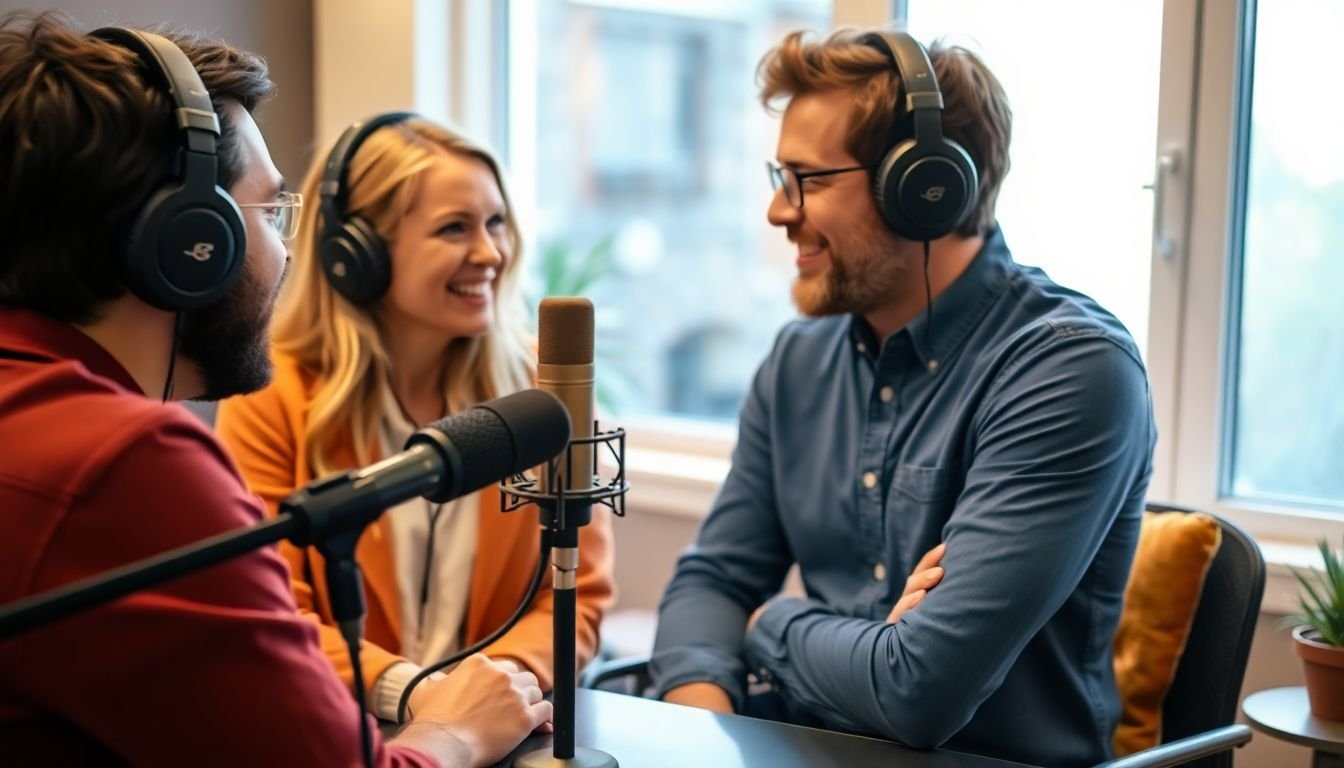
Table of Contents
Ever wondered what sets a captivating podcast interview apart from a mundane one? It’s not just about the guest’s fame or the topic’s popularity, but the art of conversation that breathes life into these audio masterpieces. As a content creator, you’re not just recording a discussion; you’re crafting an engaging narrative that resonates with your audience. So, let’s dive into the fascinating world of podcast interviewing and explore the conversation skills that transform ordinary chats into compelling content.
According to a study by Edison Research, podcast listeners are highly engaged, with 80% listening to most or all of each episode. This statistic underscores the power of a well-crafted podcast interview. But how do you ensure your conversations fall into this ‘most’ category? That’s where this article comes in.
First, let’s agree on one thing: mastering the art of podcast interviewing is a journey, not a destination. It’s about continually honing your skills, understanding your audience, and evolving with the ever-changing podcast landscape. Now, promise me you’ll stick around as we explore the intricacies of engaging conversations, from preparation to post-production.
In this comprehensive guide, we’ll delve into the heart of conversation skills, providing you with practical tips and real-life examples. We’ll explore how to research your guests, craft compelling questions, and foster a comfortable atmosphere that brings out the best in your interviewees. We’ll also discuss the art of active listening, ensuring your conversations flow naturally and authentically.
By the end of this article, you’ll not only gain a deeper understanding of the podcast interviewing process but also acquire tangible skills to elevate your content creation. So, are you ready to transform your podcast from a mere conversation into a captivating, engaging experience? Let’s get started!
Mastering the Microphone: A Comprehensive Guide to Podcast Interviewing
In the bustling world of podcasting, the art of interviewing is a skill that separates the ordinary from the extraordinary. ‘Mastering the Microphone: A Comprehensive Guide to Podcast Interviewing’ is your passport to becoming a maestro of conversation, transforming your podcast into a captivating symphony of insights and stories. This guide is not just about asking questions; it’s about crafting a dialogue that resonates, a dance of words that keeps your listeners on the edge of their seats. We’ll delve into the intricacies of preparation, the magic of open-ended questions, and the subtleties of active listening. You’ll learn how to make your guests feel at ease, drawing out their most compelling tales and profound thoughts. But it’s not just about your guests; we’ll also explore how to weave your own personality into the interview, making it a unique reflection of your voice and style. So, are you ready to don the mantle of a podcast interviewing virtuoso? Let’s embark on this journey, one question at a time.
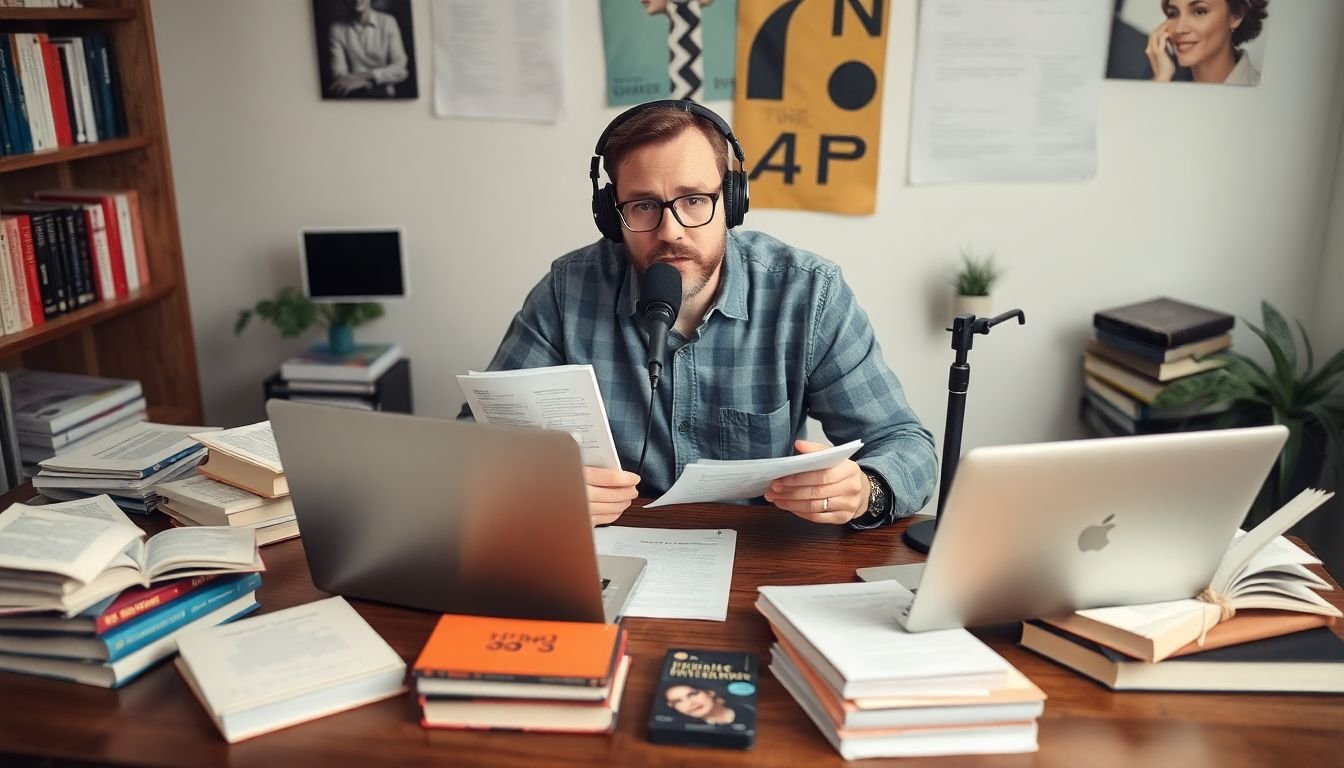
The Power of Preparation
The power of preparation in interviews is often underestimated, yet it’s the key to unlocking engaging conversations and insightful content. Before each interview, it’s crucial to invest time in thorough research and preparation. This process begins with understanding the guest’s background. Dive deep into their work, their story, their passions, and their challenges. This understanding helps you connect with them on a personal level, making the conversation flow naturally and authentically.
Formulating insightful questions is another vital aspect of preparation. These questions should stem from your research, allowing you to ask about specific projects, opinions, or experiences. They should also leave room for the guest to elaborate, encouraging a meaningful dialogue. Remember, the best interviews are conversations, not interrogations.
Structuring the conversation is equally important. This doesn’t mean scripting the entire interview, but rather having a roadmap to guide the discussion. This could include key topics you want to cover, transitions between subjects, and potential follow-up questions. It’s like planning a journey
- you might not know every turn, but having a map ensures you reach your destination.
Preparation also helps in creating engaging content. When you understand your guest’s background and have well-thought-out questions, you’re more likely to draw out compelling stories and unique perspectives. This makes your interview stand out, providing value to your audience.
Moreover, preparation fosters meaningful conversations. It shows respect for your guest’s time and expertise. It allows you to delve into complex topics with confidence, creating a safe space for your guest to share their thoughts. In essence, preparation is not just about being ready, it’s about creating an environment where both you and your guest can thrive.
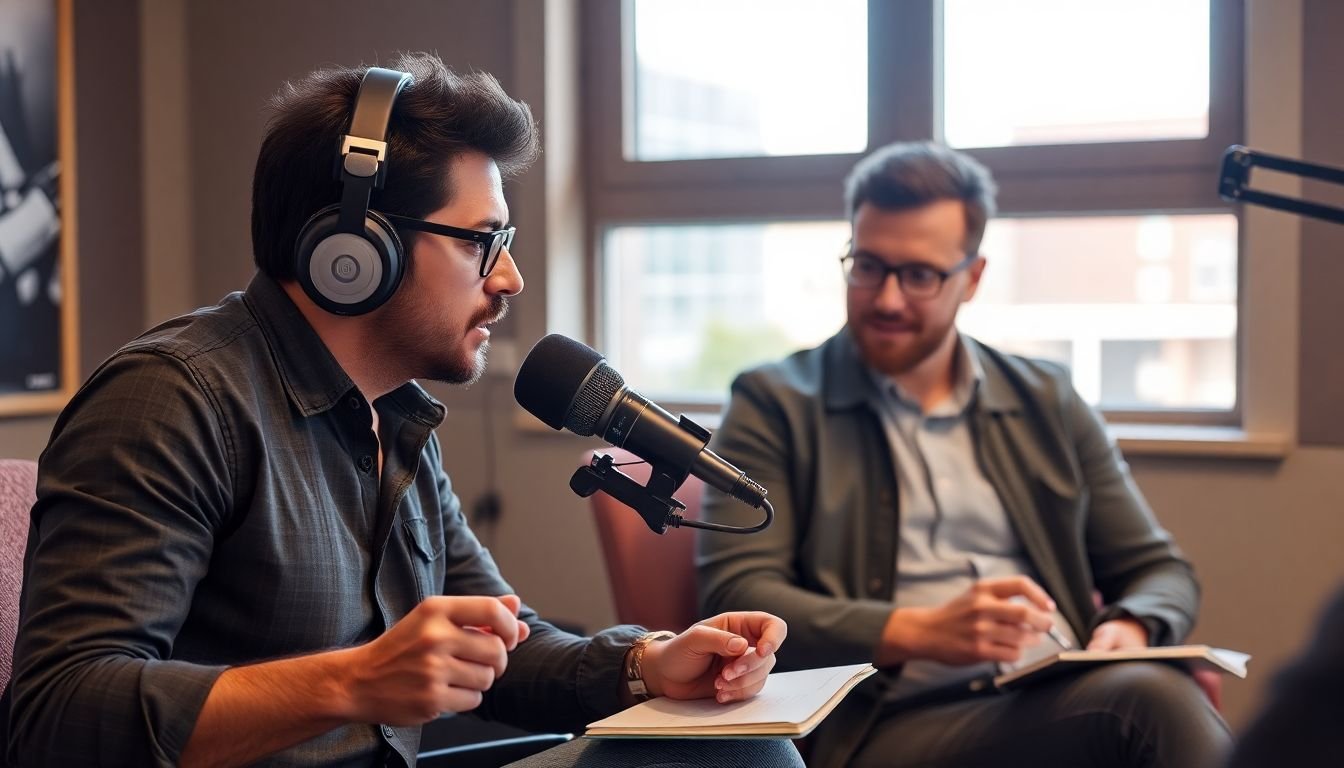
The Art of Active Listening
Active listening, an often underrated skill, plays a pivotal role in the realm of podcast interviewing. It’s not just about hearing the words, but truly understanding and engaging with the speaker. This art form transforms an interview from a mere Q&A session into a dynamic conversation, enriching both the content and the guest’s experience.
The cornerstone of active listening is the ability to show genuine interest and engagement. One technique is paraphrasing, where you rephrase the guest’s response to ensure understanding and demonstrate that you’ve been attentive. For instance, you might say, ‘So, you’re saying that…’ This not only clarifies their point but also shows respect for their perspective.
Another powerful tool is summarizing. After a series of responses, you can summarize the key points to confirm your understanding and guide the conversation forward. This helps to keep the interview focused and engaging. For example, ‘So far, we’ve discussed… Now, let’s delve into…’
Asking follow-up questions is another crucial aspect. These questions should stem from a genuine curiosity about the guest’s response, not just a pre-planned list. They can be used to explore a topic in depth, clarify a point, or even challenge the guest in a respectful manner. Here’s an example:
- Clarifying: ‘Could you elaborate more on…’
- Exploring: ‘That’s an interesting perspective. How did you come to that conclusion?’
- Challenging: ‘I see. But isn’t there a counterargument to that?’
Active listening not only improves the interview by making it more insightful and engaging, but it also enhances the guest’s experience. It shows them that their thoughts and ideas are valued, making them more likely to open up and share meaningful insights. In essence, active listening is not just a skill, but a key to unlocking compelling conversations and memorable podcast episodes.
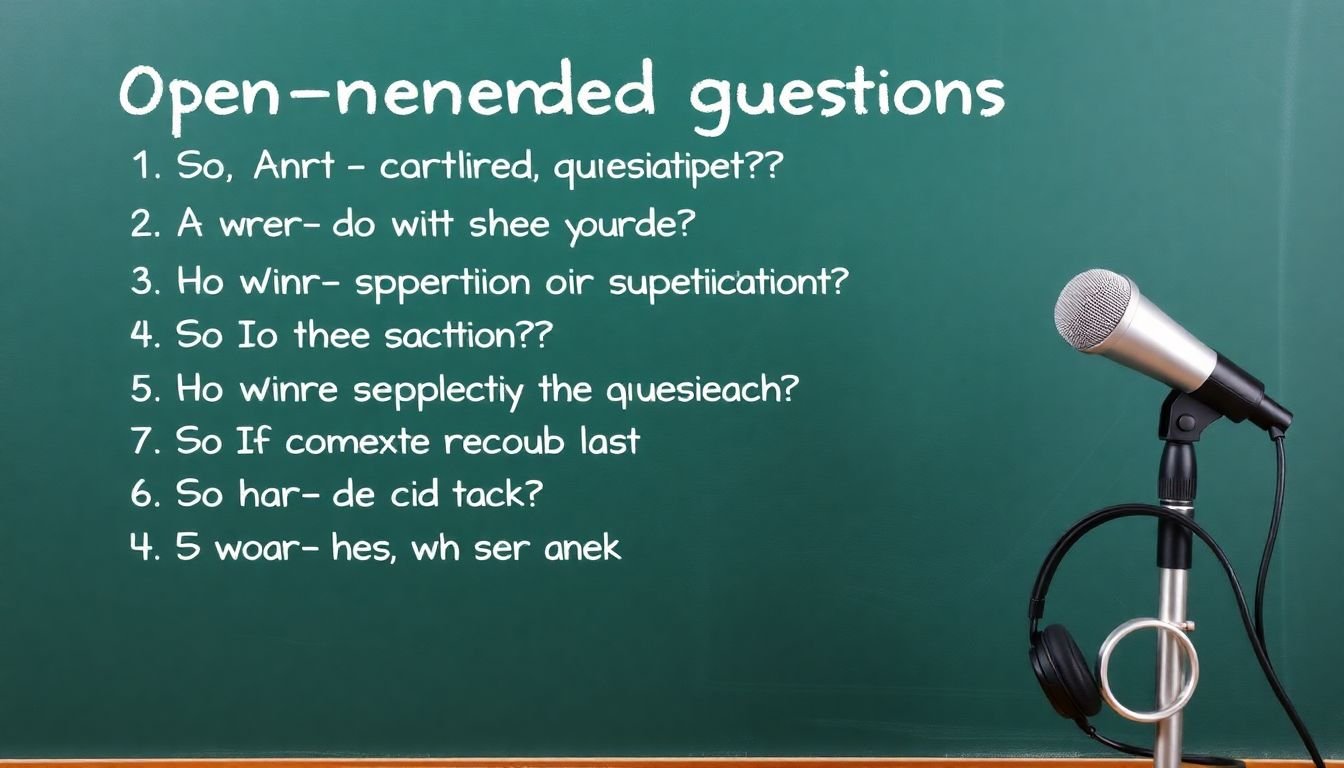
The Magic of Open-Ended Questions
In the realm of podcasting, the magic of open-ended questions is an often-overlooked yet powerful tool that can transform interviews into captivating, insightful experiences. Unlike their closed-ended counterparts, open-ended questions are not confined to a simple ‘yes’ or ‘no’ response. Instead, they encourage interviewees to explore their thoughts, memories, and experiences, thereby fostering storytelling and providing depth to conversations.
Open-ended questions are particularly effective in podcast interviews because they allow the interviewee to share their unique perspective in a detailed and engaging manner. They can be as simple as ‘Can you tell me about a time when…?’ or as complex as ‘How did your upbringing influence your approach to your career?’ The key lies in their ability to prompt the interviewee to elaborate, to delve into the nuances of their experiences, and to share stories that might otherwise remain untold.
For instance, consider the popular podcast ‘How I Built This’ hosted by Guy Raz. In each episode, Raz uses open-ended questions to guide entrepreneurs through their professional journeys. Questions like ‘What was the moment when you knew this was going to work?’ or ‘How did you navigate the challenges of scaling your business?’ are not only engaging but also provide valuable insights into the interviewee’s thought process and decision-making.
To effectively use open-ended questions in an interview, it’s crucial to understand that they are not merely questions but invitations. They invite the interviewee to share their story, their perspective, and their experiences. Here are some steps to guide you:
- Start with broad, general questions to allow the interviewee to set the stage.
- Gradually move to more specific questions to delve into the details.
- Use follow-up questions to explore interesting tangents or to clarify points made by the interviewee.
- Remember, the goal is not to get answers but to facilitate storytelling.
In essence, open-ended questions are the secret ingredient that turns a podcast interview into a compelling narrative, a journey that both the interviewer and the listener can enjoy.
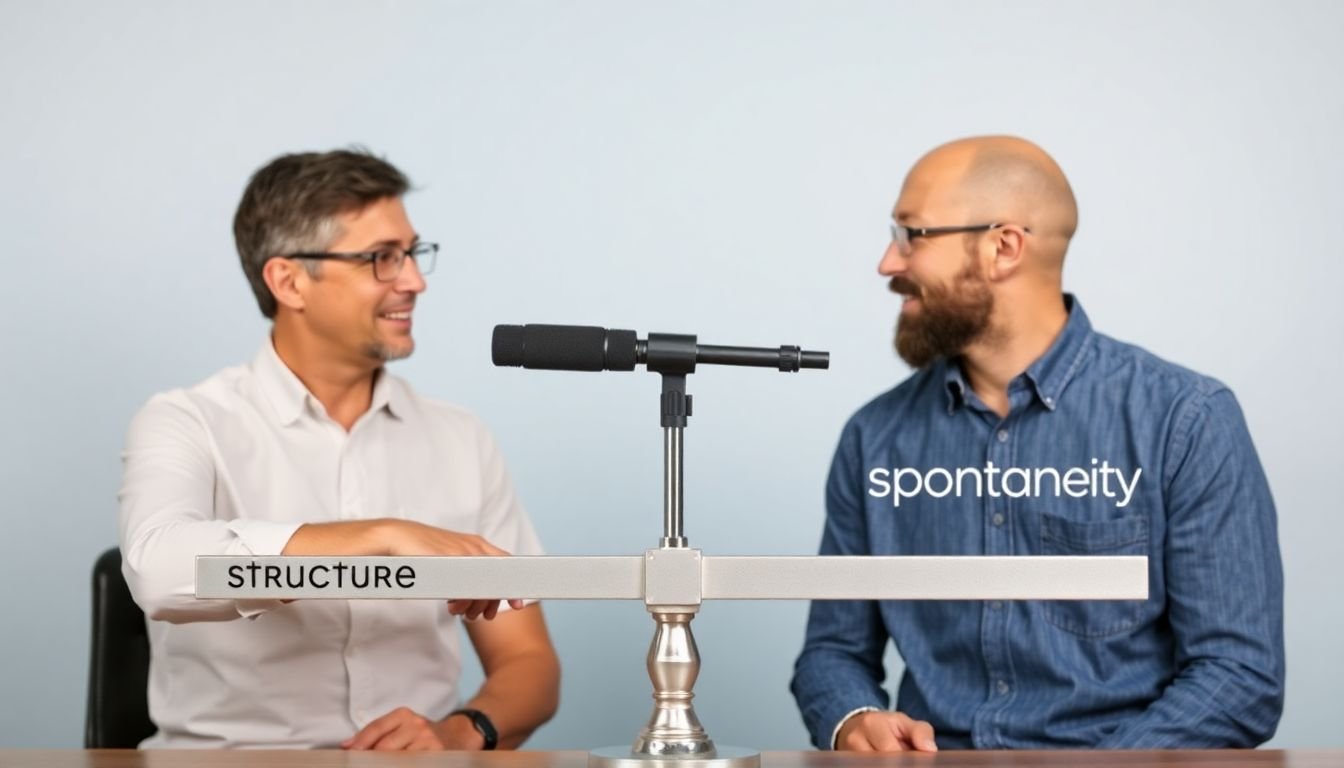
The Balance Between Structure and Spontaneity
The art of conducting a successful interview lies in the delicate balance between structure and spontaneity. Imagine a tightrope walker, arms outstretched, navigating a line high above the ground. Too much sway to one side, and they risk toppling over; too rigid, and they lose their agility. The same principle applies to interviews. A structured format provides a safety net, ensuring key points are covered and the conversation stays on track. It’s like having a well-planned route before setting off on a journey. On the other hand, spontaneity brings life and authenticity to an interview. It’s the detours, the unexpected sights, and the local insights that make a journey memorable.
Let’s start with structure. A well-defined format ensures that you cover all necessary topics, making it easier to compare responses if you’re conducting multiple interviews. It also sets clear expectations for your interviewee, reducing anxiety and encouraging more thoughtful responses. To strike this balance, begin by outlining your key questions or topics. Use open-ended questions to encourage detailed responses and avoid yes/no answers. Remember, the structure is a guide, not a straitjacket. Be ready to adapt if the conversation takes an interesting turn.
Now, let’s talk about spontaneity. Unscripted conversations can lead to unexpected insights and engaging stories. They show that you’re genuinely interested in your interviewee’s thoughts and experiences, not just ticking off a list of questions. To foster spontaneity, actively listen to the responses. Show genuine curiosity and ask follow-up questions based on what you’ve heard. This not only makes the interviewee feel valued but also leads to more candid and revealing conversations.
Striking the balance between structure and spontaneity is a skill that improves with practice. Here are some tips to help you:
- Start with a clear introduction, outlining the topics you’d like to cover. This sets expectations and allows the interviewee to mentally prepare.
- Use your structure as a loose guide. If the conversation takes an interesting turn, don’t be afraid to explore it.
- Show genuine curiosity. Ask follow-up questions based on the interviewee’s responses. This encourages them to elaborate and keeps the conversation flowing.
- Be mindful of time. While spontaneity can lead to fascinating discussions, it’s important not to stray too far from your planned topics.
In conclusion, the balance between structure and spontaneity is what makes an interview engaging and insightful. It’s about being prepared yet open, guiding the conversation while allowing it to flow naturally. So, go ahead, take that tightrope walk. With practice, you’ll find that maintaining this balance is not only possible but also rewarding.

The Role of Pauses and Silence
In the dynamic world of podcasting, the art of conversation often takes center stage, but there’s a subtle yet powerful tool that can significantly enhance the quality of interviews: pauses and silence. These often overlooked elements play a pivotal role in creating engaging and insightful content. Pauses allow guests to gather their thoughts, ensuring that their responses are well-structured and informative. They provide a moment for the interviewee to delve deeper into their memories, experiences, or ideas, leading to more profound and revealing answers. Silence also offers the listener a chance to reflect, allowing them to absorb and process the information shared, making the interview more interactive and engaging.
Moreover, pauses and silence can create a dramatic effect, much like punctuation in writing. They can emphasize a point, build suspense, or convey emotion. A well-timed pause can transform an ordinary statement into a powerful moment, making the interview more captivating and memorable. However, using pauses effectively requires a certain level of comfort and confidence. Here are some tips to help you master this art:
- Embrace the silence: Don’t feel the need to fill every moment with words. Give your guest and the listener time to absorb and reflect.
- Use pauses to emphasize: After asking a question, let the silence linger for a moment to encourage a thoughtful response. Similarly, after a guest makes a strong point, pause to let it sink in.
- Practice: Like any skill, using pauses effectively takes practice. Record yourself and listen back to identify where natural pauses can enhance your interview.
- Be comfortable with discomfort: Pauses can feel awkward at first, but remember, it’s okay to let silence hang in the air. It’s often in these moments that the most insightful responses emerge.
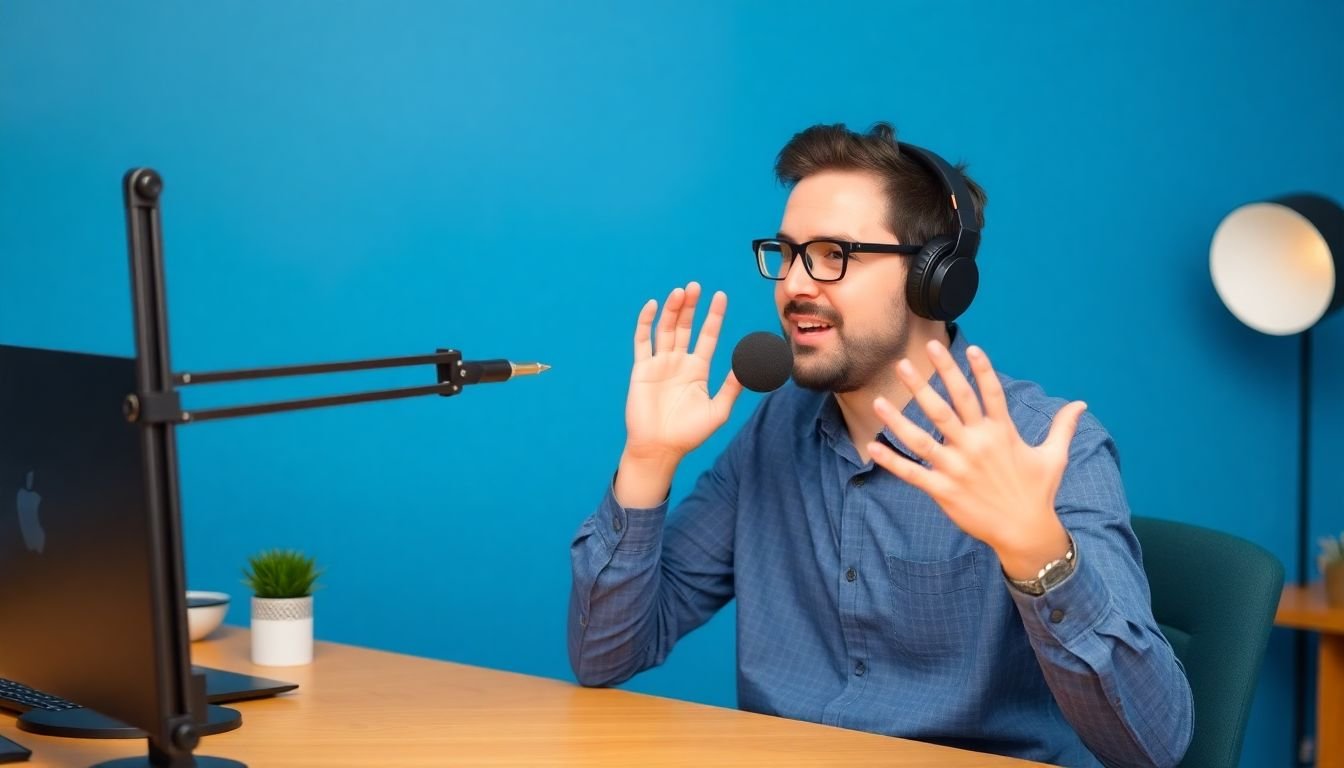
The Impact of Voice and Tone
In the realm of podcasting, the impact of voice and tone on interviews is as significant as the content itself. The voice, an interviewer’s most powerful tool, can make or break an episode. Varying your voice, much like a musician playing different notes, creates a symphony of engagement. A lower, slower pitch can emphasize a point, while a higher, quicker one can convey excitement or curiosity. This variation keeps listeners on the edge of their seats, much like a suspenseful novel.
Tone, on the other hand, is the emotional hue that colors your voice. Maintaining a positive and curious tone puts guests at ease, making them more comfortable and open to sharing their stories. It’s like inviting someone into your home; if you’re warm and welcoming, they’re more likely to relax and engage in conversation. A curious tone also signals to listeners that you’re genuinely interested in your guest, fostering a sense of authenticity.
Developing and controlling your voice and tone is a skill that improves with practice. Here are some tips to help you master this art:
- Record and listen to yourself. This might feel uncomfortable at first, but it’s the best way to understand how you sound to others.
- Practice varying your pitch and pace. Read aloud, sing, or even speak in different accents to train your vocal muscles.
- Use positive affirmations to cultivate a positive tone. Smile while you speak; it might sound clichéd, but it works.
- Prepare open-ended questions to foster curiosity. This will help you maintain an inquisitive tone throughout the interview.
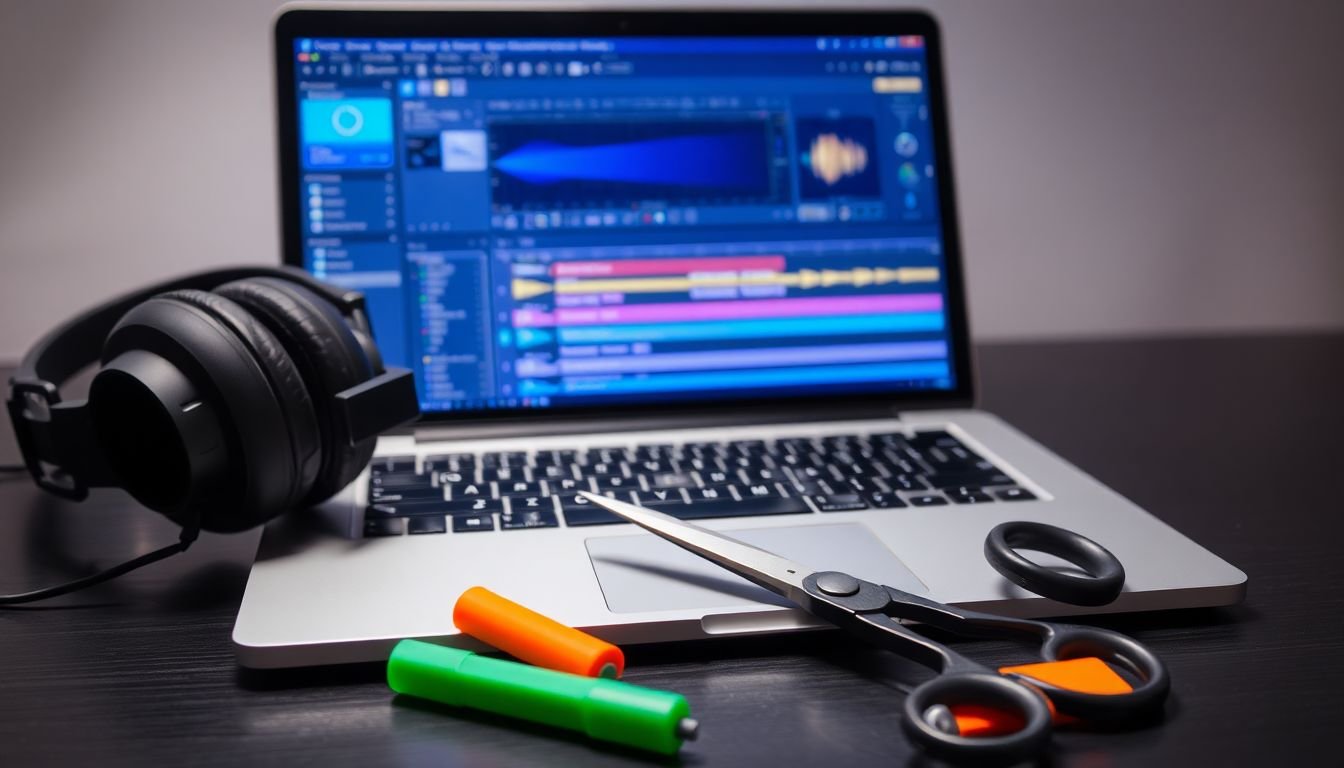
The Art of Editing: Crafting Compelling Stories
Editing is the unsung hero of podcasting, transforming raw interview footage into compelling stories that captivate audiences. It’s an art that requires a keen ear, a sharp eye, and a deep understanding of storytelling. The process begins with the raw material
- hours of conversation, filled with pauses, repetitions, and ‘ums’ and ‘ahs’. The first task is to remove the unnecessary, the filler words that don’t add value to the conversation. This isn’t about making the interviewee sound robotic, but about preserving the essence of their thoughts while making the episode easy to listen to. This is where the art of editing truly begins.
The next step is to tighten the conversation. This involves cutting out unnecessary tangents and repetitions, while ensuring the flow of the story isn’t disrupted. It’s like sculpting a statue
- you’re removing the excess marble to reveal the form within. But beware, this is where ethics come into play. It’s crucial to respect the interviewee’s intent and not manipulate their words to fit a narrative that isn’t true.
Once the conversation is tightened, it’s time to structure the story for maximum impact. This could involve moving sections around to create a compelling narrative arc, or breaking the episode into segments with introductions and conclusions. It’s about understanding what makes a good story
- a beginning, a middle, and an end
- and using that to guide your editing decisions.
Here are some tips for editing interviews ethically and effectively:
- Always listen to the entire interview before you start editing. This gives you a sense of the overall narrative and helps you make decisions about what to include and what to leave out.
- Use silence to your advantage. Pauses can be powerful tools for emphasis and can make the listener lean in.
- If you’re cutting out a section that changes the meaning of what’s being said, consider adding a transition or an explanation to maintain context.
- Respect the interviewee’s intent. If they’re trying to make a point, don’t cut around it just because it’s not convenient for your narrative.
- Finally, always remember that the goal of editing is to serve the story. It’s not about making yourself sound smart, or making the interviewee sound perfect. It’s about creating a compelling, engaging experience for the listener.

The Power of Authenticity and Vulnerability
In the realm of podcasting, authenticity and vulnerability are not just buzzwords; they are the secret sauce that transforms ordinary interviews into captivating, heartfelt experiences. When we peel back the layers of professionalism and allow our genuine selves to shine through, we create a space where both guests and listeners feel seen, heard, and understood. This is the power of authenticity and vulnerability.
Sharing personal experiences is the first step in this journey. It’s like extending an invitation to your guests and listeners to step into your world, to understand your perspective, and to relate to your struggles and triumphs. When you share a story about a mistake you’ve made, a challenge you’ve overcome, or a lesson you’ve learned, you’re not just entertaining; you’re connecting on a human level. This connection fosters empathy and understanding, making your podcast a safe haven where people can be their authentic selves.
Admitting mistakes is another powerful way to embrace vulnerability. It’s easy to present a polished, perfect image, but it’s the cracks that let the light in. When you openly discuss your failures, you’re not only humanizing yourself but also creating an environment where your guests feel comfortable doing the same. This can lead to profound conversations that go beyond the surface level, delving into the nitty-gritty of personal growth and self-awareness.
Asking challenging questions is also key to elevating your interviews. It’s not about ambush journalism, but rather about digging deeper, exploring complex topics, and encouraging your guests to think critically. When you ask questions that make your guests pause, reflect, and sometimes even squirm, you’re pushing the boundaries of conventional interviews. This can lead to unexpected insights and revelations that resonate with your listeners.
To create a safe and open environment for authentic conversations, consider the following tips:
- Establish trust: Be transparent about your intentions and create a space where your guests feel comfortable being vulnerable.
- Active listening: Show genuine interest in your guests’ responses. Ask follow-up questions based on what they’ve shared.
- Respect boundaries: While it’s important to delve deep, it’s equally crucial to respect your guests’ boundaries. If they’re not comfortable discussing a topic, respect their decision.
- Self-reflection: Be open to learning from your guests. Authenticity is a two-way street, and sometimes, your guests can teach you a thing or two about yourself.
In conclusion, authenticity and vulnerability are not just about being real; they’re about creating a space where others feel safe to be real too. It’s about the power of connection, the courage to be imperfect, and the transformative potential of honest conversations. So, go ahead, embrace your vulnerability, and watch as your podcast interviews become a beacon of authenticity in the vast sea of content.

The Importance of Feedback and Iteration
The art of podcast interviewing is a journey of continuous refinement, and two of its most powerful tools are feedback and iteration. Feedback, the lifeblood of growth, comes in various forms, each offering unique insights to enhance your interviewing skills. Firstly, your guests, the lifeblood of your podcast, can provide invaluable feedback. They bring a fresh perspective, offering insights into what worked and what didn’t from their side of the microphone. They can tell you if you asked the right questions, if you listened attentively, or if you steered the conversation in engaging directions. Their feedback can help you understand your strengths and areas for improvement, allowing you to tailor your approach to better suit your guests and your audience.
Listeners, the reason you create your podcast, are another rich source of feedback. They bring a different perspective, one that’s not clouded by the interview process. They can tell you if they found the interview engaging, if they learned something new, or if they were left wanting more. Their feedback can help you understand what resonates with your audience and what doesn’t, allowing you to shape your interviews to better serve their interests.
Mentors, those who have walked the path before you, offer a wealth of experience and wisdom. They can provide constructive criticism, share best practices, and offer guidance on how to improve. Their feedback can help you avoid common pitfalls and shortcut your learning curve.
Iteration, the process of continually refining your approach based on the feedback received, is the key to turning insights into improvements. It’s about taking the time to reflect on what worked and what didn’t, then making adjustments to your approach. It’s about being open to change, willing to experiment, and eager to learn. It’s about turning each interview into a learning experience, using it to inform the next one.
By seeking feedback and continually refining your approach, you’re not just improving your interviewing skills, you’re also fostering personal growth. You’re learning to listen more effectively, to communicate more clearly, and to understand different perspectives. You’re learning to be open to criticism, to value constructive feedback, and to use it to drive improvement. You’re learning to iterate, to adapt, and to grow. And that, in essence, is the importance of feedback and iteration in the world of podcast interviewing.
FAQ
What are the key conversation skills essential for a successful podcast interview?
How can I prepare for a podcast interview to ensure engaging content?
- create a list of open-ended questions that will guide the conversation,
- but also be prepared to deviate from the script if something interesting comes up,
- and ensure you have a mix of questions that cover their work, personal experiences, and opinions.
Lastly, familiarize yourself with their previous interviews or work to avoid asking questions they’ve already answered elsewhere.
What role does active listening play in podcast interviewing?
- paraphrase their points to ensure understanding and show engagement,
- ask follow-up questions based on their responses,
- and avoid interrupting or judging their answers.
By actively listening, you create a safe space for your guest to share their thoughts openly, leading to more engaging conversations.
How can I keep the conversation flowing naturally during a podcast interview?
- use transitions to connect ideas, such as ‘building on that…’ or ‘that reminds me of…’,
- encourage your guest to elaborate on their points with phrases like ‘tell me more about that…’,
- and be open to going off-script if something unexpected but interesting comes up.
Remember, the goal is to have a engaging conversation, not to stick rigidly to a pre-planned list of questions.
What should I do if I’m not sure how to respond to my guest’s answer?
How can I create a comfortable and engaging environment for my guest?
- send them a list of topics you’d like to cover to help them prepare,
- and reassure them that it’s okay to be themselves and share their opinions.
During the interview,
- show genuine interest in their responses,
- be open to their ideas and perspectives,
- and use humor appropriately to lighten the mood, if it comes naturally to you.
Lastly, ensure the technical aspects are taken care of, such as good audio quality and a stable internet connection, to minimize distractions.
What if my guest is nervous or not very talkative?
- ask open-ended questions that can’t be answered with a simple ‘yes’ or ‘no’,
- show genuine interest in their responses, and
- use positive reinforcement by nodding, smiling, or verbally acknowledging their points.
If they still struggle, you might need to adjust your questions or even the topic of the interview to find something that sparks their enthusiasm.